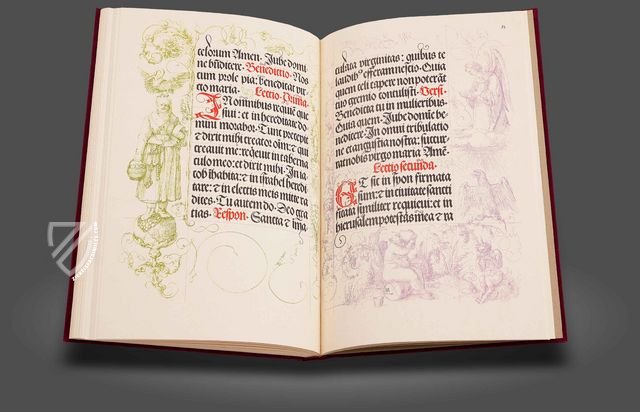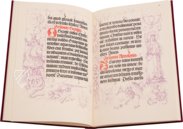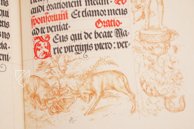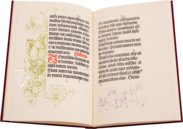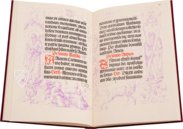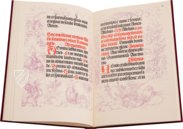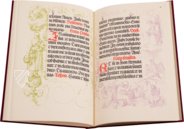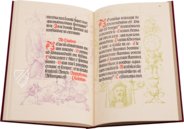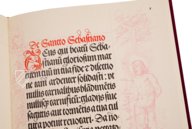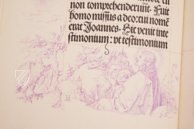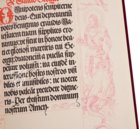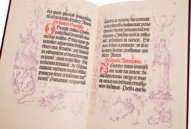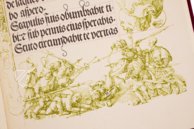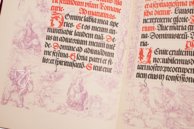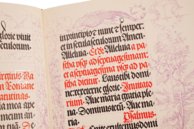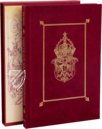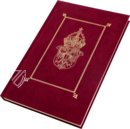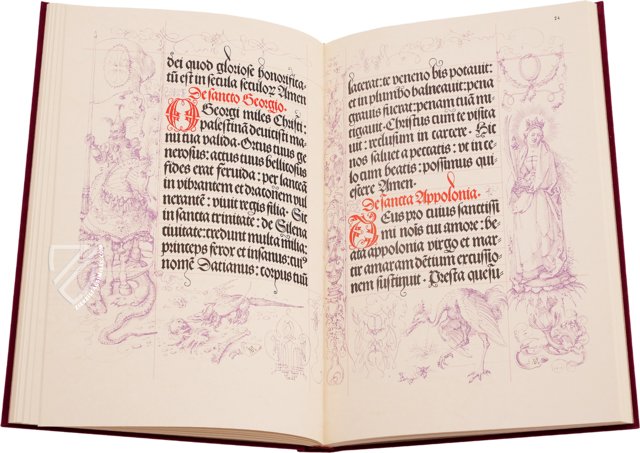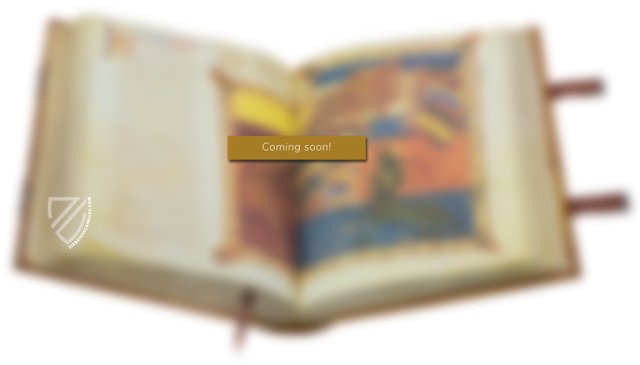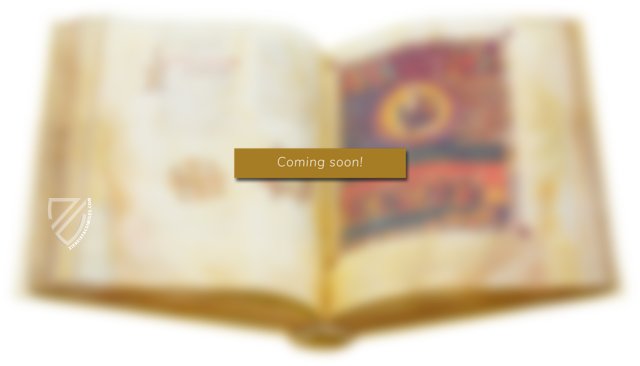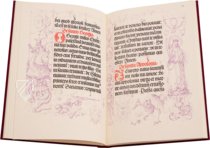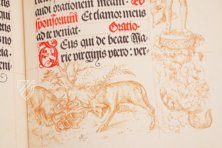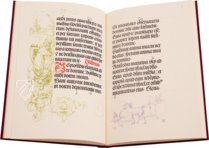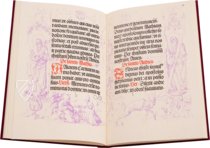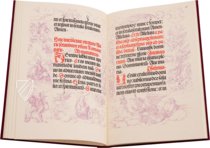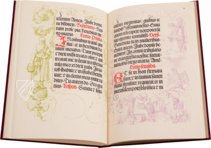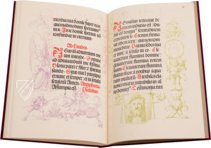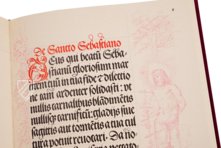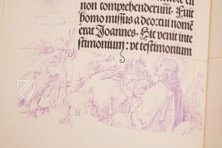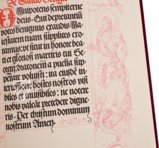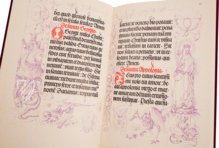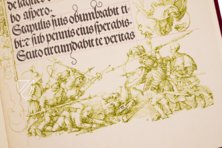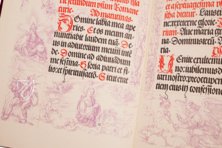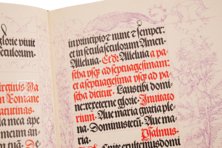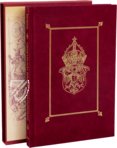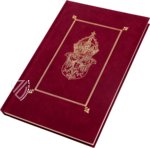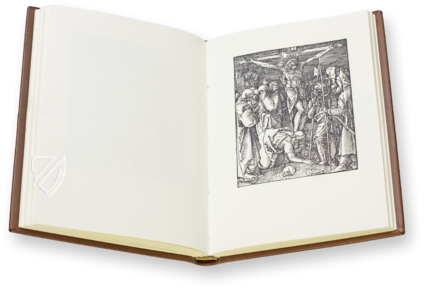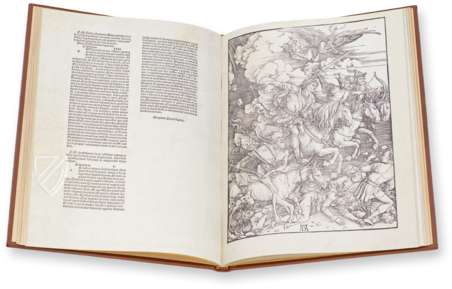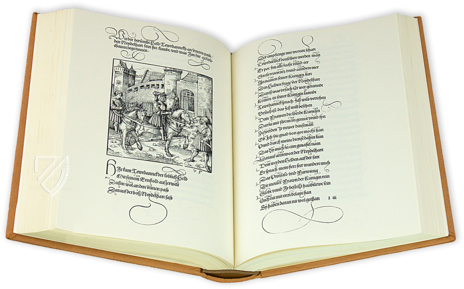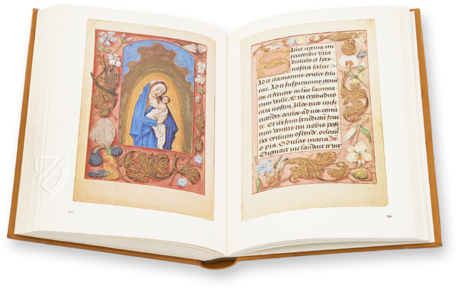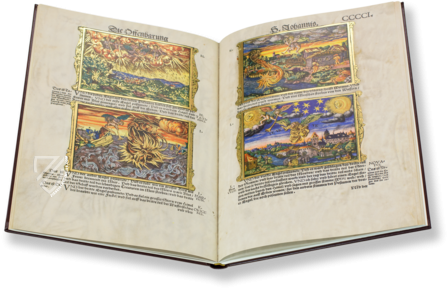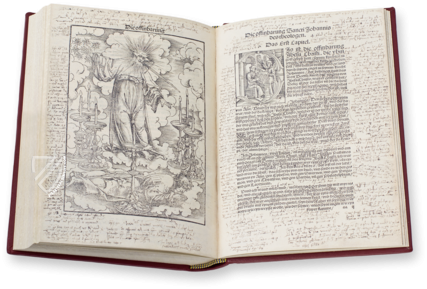Munich-Besançon Prayer Book of Maximilian I
(under 1,000€)
Published in a limited run of ten copies, this splendid prayer book was printed on parchment in 1513 for the use of Emperor Maximilian I and his close supporters. This select group was designed to look like manuscripts and feature hand painted initials adorning the printed text, which uses an early form of Fraktur. One of the copies, believed to have been owned by the Emperor himself, was furnished with marginal pen and ink drawings by some of the finest masters of the period. A fragment of this manuscript, which is found today in Munich, features extraordinarily detailed and artful drawings in the grisaille style by no less than the famous German Renaissance masters Albrecht Dürer and Lucas Cranach the Elder. Aside from gorgeous and terrifying biblical scenes, an incredible variety of secular motifs adorns the margins of this fascinating synthesis of the arts.
Albrecht Dürer's and Lucas Cranach's Marginal Drawings in the Prayer Book of Emperor Maximilian I
The Prayer Book of Emperor Maximilian I is a Latin text published in 1513 by the imperial court printer Johann Schönsperger the Elder (ca. 1455-1521) in Augsburg, Germany. It was a parchment edition of only ten copies intended either for the personal use of Emperor Maximilian I (1459-1518), members of the Order of St. George, or those close to the Emperor. It is famous for its ornate typography with an early version of Fraktur, but one copy was additionally adorned with marginal drawings by leading artists of the time ca. 1514-15. For whom this sample was intended is unknown today, but researchers generally believe that it was made for Maximilian I. The precious book was divided at an unknown time with one section going to Besançon and the other to Munich, where it arrived ca. 1598-1600. The Munich manuscript is famous for its incredible marginal drawings from two of the most important artists of the German Renaissance: Albrecht Dürer (1471-1528) and Lucas Cranach the Elder (1472-1553).
Marginal Grisaille Masterpieces
The pen and ink drawings are monochrome, either black, red, or blue, and make masterful use of the grisaille technique, which emphasizes shading and detail over color. Aside from religious imagery typical for a prayer book, there are numerous secular scenes as well including doctors and musicians, strangely dressed foreigners, flora and fauna, hybrid creatures and other drolleries, and various battle scenes. The attention to detail and masterful execution of the artwork is all the more impressive considering that it was executed in the limited space surrounding the text, which was not originally designed by the rubricator to leave room for such embellishment. Nonetheless, these masterful drawings from the hands of Dürer and Cranach are a testament to the skill of two of the greatest artists of the Northern Renaissance.
Codicology
- Alternative Titles
- Albrecht Dürers und Lukas Cranachs Randzeichnungen zum Gebetbuche Kaiser Maximilians I in der Bayerischen Staatsbibliothek zu München
Gebetbuch Maximilians I
Albrecht Dürers und Lucas Cranachs Randzeichnungen im Gebetbuch Kaiser Maximilians I.
Gebetbuch Kaiser Maximilians mit den Randzeichnungen von Albrecht Dürer und Lucas Cranach dem Älterern
Munich-Besançon Prayer Book of Maximilian I
Prayer Book of Emperor Maximilian I with Albrecht Dürer's and Lucas Cranach's Marginal Drawings - Origin
- Germany
- Date
- 1514–1515
- Epochs
- Style
- Genre
- Language
- Script
- Early version of Fraktur
- Illustrations
- Masterful monochrome pen and ink drawings
- Artist / School
- Albrecht Dürer (illuminator)
Lucas Cranach the Elder (illuminator) - Previous Owners
- Emperor Maximilian I
Prayer Book of Emperor Maximilian I with Albrecht Dürer's and Lucas Cranach's Marginal Drawings
Fighting Bucks
During the rut, the mating season of various ruminants including deer, the males experience an increase in testosterone that not only drives them to find females to breed with but also causes them to fight one another. In fact, antlers are used primarily for fighting other bucks rather than predators, which deer can easily outrun. This image of a young buck challenging an older one is the work of Lucas Cranach the Elder, who used a winged snake with a ruby ring as his signature (not pictured).
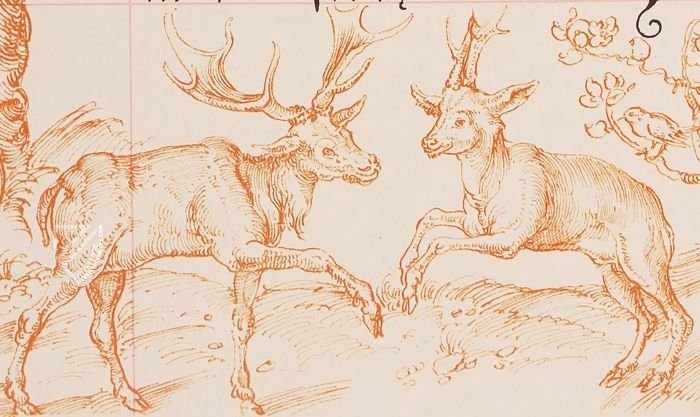
Prayer Book of Emperor Maximilian I with Albrecht Dürer's and Lucas Cranach's Marginal Drawings
Pater Noster
Rather than the standard text of the Lord’s Prayer, this prayer is actually the Memento comprehensionis et temptationis tuae. Nonetheless, these splendid marginal drawings from the hand of Albrecht Dürer, whose iconic monogram signature is barely visible under the fox, clearly makes an illusion to the famous line “lead us not into temptation”.
A richly dressed Landsknecht armed with a halberd looks on as a fox lures chickens by playing a flute. Pope Gregory I declared the rooster the emblem of Christianity and Pope Nicholas I declared that the figure of the rooster should be placed on every church steeple. The rooster specifically symbolizes Christian vigilance because it announces the coming of morning, chasing away the devil and his demons.
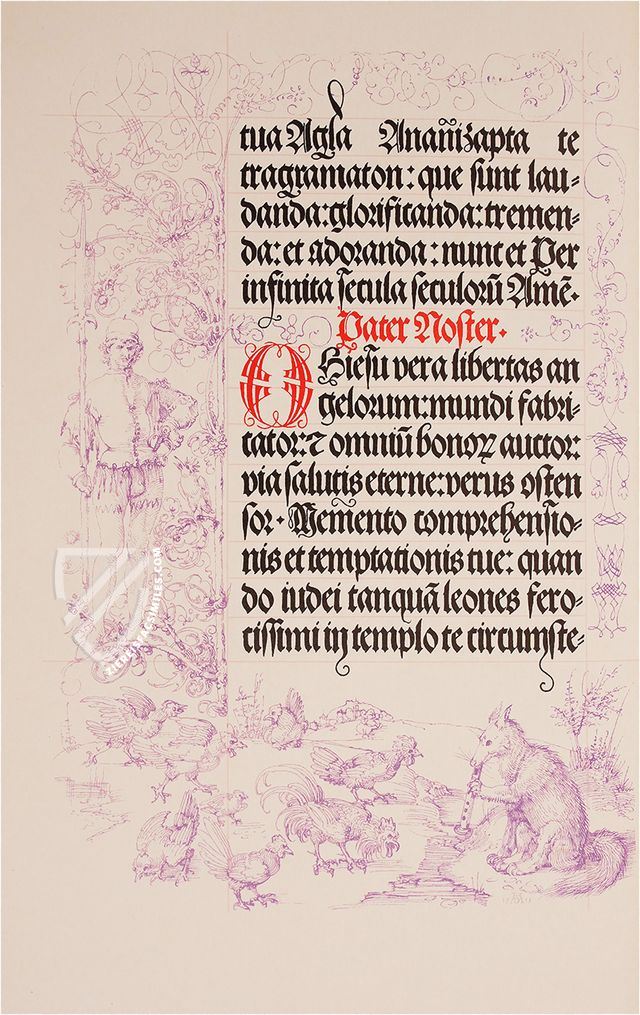
#1 Albrecht Dürers und Lukas Cranachs Randzeichnungen zum Gebetbuche Kaiser Maximilians I in der Bayerischen Staatsbibliothek zu München
Language: German
(under 1,000€)
#2 Das Gebetbuch Kaiser Maximilians I
Language: German
(under 1,000€)
#3 Albrecht Dürers und Lukas Cranachs Randzeichnungen zum Gebetbuche Kaiser Maximilians I in der Bayerischen Staatsbibliothek zu München
Language: German
(under 1,000€)
- Treatises / Secular Books
- Apocalypses / Beatus
- Astronomy / Astrology
- Bestiaries
- Bibles / Gospels
- Chronicles / History / Law
- Geography / Maps
- Saints' Lives
- Islam / Oriental
- Judaism / Hebrew
- Single Leaf Collections
- Leonardo da Vinci
- Literature / Poetry
- Liturgical Manuscripts
- Medicine / Botany / Alchemy
- Music
- Mythology / Prophecies
- Psalters
- Other Religious Books
- Games / Hunting
- Private Devotion Books
- Other Genres
- Afghanistan
- Armenia
- Austria
- Belgium
- Belize
- Bosnia and Herzegovina
- China
- Colombia
- Costa Rica
- Croatia
- Cyprus
- Czech Republic
- Denmark
- Egypt
- El Salvador
- Ethiopia
- France
- Germany
- Greece
- Guatemala
- Honduras
- Hungary
- India
- Iran
- Iraq
- Israel
- Italy
- Japan
- Jordan
- Kazakhstan
- Kyrgyzstan
- Lebanon
- Liechtenstein
- Luxembourg
- Mexico
- Morocco
- Netherlands
- Palestine
- Panama
- Peru
- Poland
- Portugal
- Romania
- Russia
- Serbia
- Spain
- Sri Lanka
- Sweden
- Switzerland
- Syria
- Tajikistan
- Turkey
- Turkmenistan
- Ukraine
- United Kingdom
- United States
- Uzbekistan
- Vatican City
- A. Oosthoek, van Holkema & Warendorf
- Aboca Museum
- Ajuntament de Valencia
- Akademie Verlag
- Akademische Druck- u. Verlagsanstalt (ADEVA)
- Aldo Ausilio Editore - Bottega d’Erasmo
- Alecto Historical Editions
- Alkuin Verlag
- Almqvist & Wiksell
- Amilcare Pizzi
- Andreas & Andreas Verlagsbuchhandlung
- Archa 90
- Archiv Verlag
- Archivi Edizioni
- Arnold Verlag
- ARS
- Ars Magna
- ArtCodex
- AyN Ediciones
- Azimuth Editions
- Badenia Verlag
- Bärenreiter-Verlag
- Belser Verlag
- Belser Verlag / WK Wertkontor
- Benziger Verlag
- Bernardinum Wydawnictwo
- BiblioGemma
- Biblioteca Apostolica Vaticana (Vaticanstadt, Vaticanstadt)
- Bibliotheca Palatina Faksimile Verlag
- Bibliotheca Rara
- Boydell & Brewer
- Bramante Edizioni
- Bredius Genootschap
- Brepols Publishers
- British Library
- C. Weckesser
- Caixa Catalunya
- Canesi
- CAPSA, Ars Scriptoria
- Caratzas Brothers, Publishers
- Carus Verlag
- Casamassima Libri
- Centrum Cartographie Verlag GmbH
- Chavane Verlag
- Christian Brandstätter Verlag
- Circulo Cientifico
- Club Bibliófilo Versol
- Club du Livre
- CM Editores
- Collegium Graphicum
- Collezione Apocrifa Da Vinci
- Comissão Nacional para as Comemorações dos Descobrimentos Portugueses
- Coron Verlag
- Corvina
- CTHS
- D. S. Brewer
- Damon
- De Agostini/UTET
- De Nederlandsche Boekhandel
- De Schutter
- Deuschle & Stemmle
- Deutscher Verlag für Kunstwissenschaft
- DIAMM
- Droz
- E. Schreiber Graphische Kunstanstalten
- Ediciones Boreal
- Ediciones Grial
- Ediclube
- Edições Inapa
- Edilan
- Editalia
- Edition Deuschle
- Edition Georg Popp
- Edition Leipzig
- Edition Libri Illustri
- Editiones Reales Sitios S. L.
- Éditions de l'Oiseau Lyre
- Editions Medicina Rara
- Editorial Casariego
- Editorial Mintzoa
- Editrice Antenore
- Editrice Velar
- Edizioni Edison
- Egeria, S.L.
- Eikon Editores
- Electa
- Emery Walker Limited
- Enciclopèdia Catalana
- Eos-Verlag
- Ephesus Publishing
- Ernst Battenberg
- Eugrammia Press
- Extraordinary Editions
- Fackelverlag
- Facsimila Art & Edition
- Facsimile Editions Ltd.
- Facsimilia Art & Edition Ebert KG
- Faksimile Verlag
- Feuermann Verlag
- Folger Shakespeare Library
- Franco Cosimo Panini Editore
- Friedrich Wittig Verlag
- Fundación Hullera Vasco-Leonesa
- G. Braziller
- Gabriele Mazzotta Editore
- Gebr. Mann Verlag
- Gesellschaft für graphische Industrie
- Getty Research Institute
- Giovanni Domenico de Rossi
- Giunti Editore
- Graffiti
- Grafica European Center of Fine Arts
- Guido Pressler
- Guillermo Blazquez
- Gustav Kiepenheuer
- H. N. Abrams
- Harrassowitz
- Harvard University Press
- Helikon
- Hendrickson Publishers
- Henning Oppermann
- Herder Verlag
- Hes & De Graaf Publishers
- Hoepli
- Holbein-Verlag
- Houghton Library
- Hugo Schmidt Verlag
- Idion Verlag
- Il Bulino, edizioni d'arte
- ILte
- Imago
- Insel Verlag
- Insel-Verlag Anton Kippenberger
- Instituto de Estudios Altoaragoneses
- Instituto Nacional de Antropología e Historia
- Introligatornia Budnik Jerzy
- Istituto dell'Enciclopedia Italiana - Treccani
- Istituto Ellenico di Studi Bizantini e Postbizantini
- Istituto Geografico De Agostini
- Istituto Poligrafico e Zecca dello Stato
- Italarte Art Establishments
- Jan Thorbecke Verlag
- Johnson Reprint Corporation
- Josef Stocker
- Josef Stocker-Schmid
- Jugoslavija
- Karl W. Hiersemann
- Kasper Straube
- Kaydeda Ediciones
- Kindler Verlag / Coron Verlag
- Kodansha International Ltd.
- Konrad Kölbl Verlag
- Kurt Wolff Verlag
- La Liberia dello Stato
- La Linea Editrice
- La Meta Editore
- Lambert Schneider
- Landeskreditbank Baden-Württemberg
- Leo S. Olschki
- Les Incunables
- Liber Artis
- Library of Congress
- Libreria Musicale Italiana
- Lichtdruck
- Lito Immagine Editore
- Lumen Artis
- Lund Humphries
- M. Moleiro Editor
- Maison des Sciences de l'homme et de la société de Poitiers
- Manuscriptum
- Martinus Nijhoff
- Maruzen-Yushodo Co. Ltd.
- MASA
- Massada Publishers
- McGraw-Hill
- Metropolitan Museum of Art
- Militos
- Millennium Liber
- Müller & Schindler
- Nahar - Stavit
- Nahar and Steimatzky
- National Library of Wales
- Neri Pozza
- Nova Charta
- Oceanum Verlag
- Odeon
- Orbis Mediaevalis
- Orbis Pictus
- Österreichische Staatsdruckerei
- Oxford University Press
- Pageant Books
- Parzellers Buchverlag
- Patrimonio Ediciones
- Pattloch Verlag
- PIAF
- Pieper Verlag
- Plon-Nourrit et cie
- Poligrafiche Bolis
- Presses Universitaires de Strasbourg
- Prestel Verlag
- Princeton University Press
- Prisma Verlag
- Priuli & Verlucca, editori
- Pro Sport Verlag
- Propyläen Verlag
- Pytheas Books
- Quaternio Verlag Luzern
- Reales Sitios
- Recht-Verlag
- Reichert Verlag
- Reichsdruckerei
- Reprint Verlag
- Riehn & Reusch
- Roberto Vattori Editore
- Rosenkilde and Bagger
- Roxburghe Club
- Salerno Editrice
- Saltellus Press
- Sandoz
- Sarajevo Svjetlost
- Schöck ArtPrint Kft.
- Schulsinger Brothers
- Scolar Press
- Scrinium
- Scripta Maneant
- Scriptorium
- Shazar
- Siloé, arte y bibliofilia
- SISMEL - Edizioni del Galluzzo
- Sociedad Mexicana de Antropología
- Société des Bibliophiles & Iconophiles de Belgique
- Soncin Publishing
- Sorli Ediciones
- Stainer and Bell
- Studer
- Styria Verlag
- Sumptibus Pragopress
- Szegedi Tudomànyegyetem
- Taberna Libraria
- Tarshish Books
- Taschen
- Tempus Libri
- Testimonio Compañía Editorial
- Thames and Hudson
- The Clear Vue Publishing Partnership Limited
- The Facsimile Codex
- The Folio Society
- The Marquess of Normanby
- The Richard III and Yorkist History Trust
- Tip.Le.Co
- TouchArt
- TREC Publishing House
- TRI Publishing Co.
- Trident Editore
- Tuliba Collection
- Typis Regiae Officinae Polygraphicae
- Union Verlag Berlin
- Universidad de Granada
- University of California Press
- University of Chicago Press
- Urs Graf
- Vallecchi
- Van Wijnen
- VCH, Acta Humaniora
- VDI Verlag
- VEB Deutscher Verlag für Musik
- Verlag Anton Pustet / Andreas Verlag
- Verlag Bibliophile Drucke Josef Stocker
- Verlag der Münchner Drucke
- Verlag für Regionalgeschichte
- Verlag Styria
- Vicent Garcia Editores
- W. Turnowski Ltd.
- W. Turnowsky
- Waanders Printers
- Wiener Mechitharisten-Congregation (Wien, Österreich)
- Wissenschaftliche Buchgesellschaft
- Wissenschaftliche Verlagsgesellschaft
- Wydawnictwo Dolnoslaskie
- Xuntanza Editorial
- Zakład Narodowy
- Zollikofer AG

